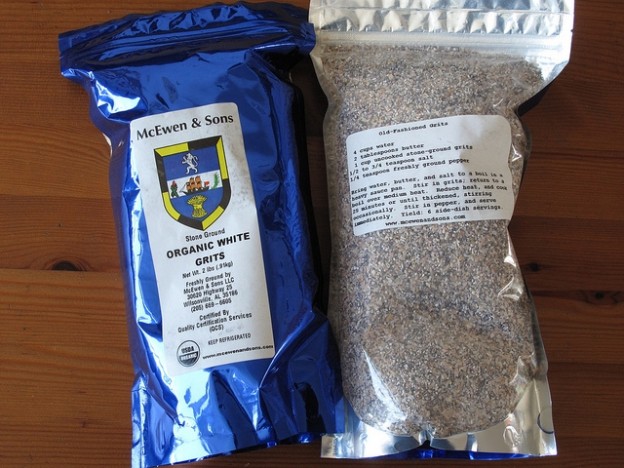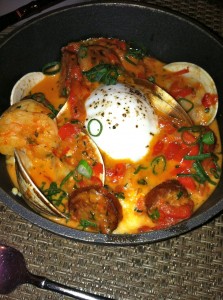
Photo: Mat Honan/Flickr
You don’t need to be a native of the South to enjoy this most classic of southern fare. Kathy Gunst, Resident Chef of Here & Now, explains.
Kathy Gunst
Cookbook author, blogger
For a girl who grew up in suburban New York, I have become awfully fond of grits. For those of you who don’t know much about grits (which generally means you haven’t spent much time in the South, where they command a nearly religious devotion), they are a staple of Southern cooking, a ground cornmeal “mush” or porridge, similar to polenta, but to my mind (and palette) a whole lot more interesting.
Grits (or hominy) is one of the first truly American foods. Introduced by Native Americans who ate softened corn, or maize, grits are so ingrained in Southern culture that, back in 1976, South Carolina declared it the “official state food.” As the State Legislature pointed out “…every community in the State of South Carolina used to be the site of a grist mill, and every local economy in the State used to be dependent on its product.” The Legislature went on: “…[G]rits has been a part of the life of every South Carolinian of whatever race, background, gender and income.”
My personal back story with grits begins in Charleston: my daughter is a student at the College of Charleston. This is a good thing for many reasons. First, it’s a great school. Secondly, Charleston is a city filled with stunning architecture, gardens and art. The food is so good that Emma has become a bit obsessed. She has even started her own blog for college students that focuses on eating and cooking healthy, inexpensive meals.
In a recent, three-day eating adventure through Charleston, what made the deepest impression on me were the dishes that included or featured grits. Although grits are most typically served for breakfast with eggs, sausage, and biscuits (the way northerners might serve home fried potatoes) Southern chefs these days are taking this common ground cornmeal and elevating it to new heights.

Photo: Kathy Gunst
At Husk in Charleston’s historic district, Chef Sean Brock, the new darling of the food world, who was featured recently in a lengthy New Yorker profile, served grits topped with local clams, shrimp, tomato braised peppers and onions, house-made sausage and a soft poached egg. Locally, ground cornmeal is also used to make cornbread. At Husk it arrives at the table piping hot, straight out of a wood-burning oven, in a small 6-inch black cast iron skillet, charred on one side and flecked with coarse cornmeal and bits of bacon.
Shrimp and grits are a classic combination. In Charleston they are considered breakfast fare. Often called “breakfast shrimp,” the dish is made up of creamy grits topped with shrimp cooked in bacon fat. (Other than cornmeal, pork, and in particular bacon and bacon fat, feature prominently in this highly flavored cuisine.) At Hominy Grill we ate a sophisticated version of this dish with pink shrimp and grits flavored with mushrooms, scallions and bacon, accompanied by a fluffy buttermilk biscuit. A horseradish and beer-spiked bloody Mary, topped with pickled okra, helped wash it all down.
Grits, to be truthful, are like a blank canvas just begging to be splashed with color. You can top them or serve them alongside poached eggs, seafood, meat, poultry, sautéed or roasted vegetables — virtually anything.
The basic formula: 1 cup of grits to 2 to 4 parts liquid (which is typically water, but can also be a combination of water/cream/milk/stock). Grits expand when cooked and need to be stirred — much like making risotto, only easier. The cooking time varies depending on the coarseness of the corn. Coarse corn will take close to an hour to become tender, while finer ground corn cooks in 15 to 25 minutes. (Instant grits are frowned upon by real Southern cooks.)
Grits tend to be a whole lot better eaten right away, rather than later. However, there is one exception. Leftover grits make wonderful “grits pancakes,” topped with a fried or poached egg, some roasted or sautéed greens or vegetables.

Photo: Kathy Gunst
This morning, back in Maine on a cold February day, I formed leftover grits from last night’s dinner into pancakes and sautéed them lightly in olive oil (if I were truly Southern, I would have used pork fat or lard) until they had a gorgeous golden brown “crust.” I fried an egg to go with the grit pancakes and reheated some leftover roasted vegetables and tried hard not to miss my daughter too much, or the warmth of the South.
Not-So Basic Grits
Here’s the recipe for making grits. You can top them with steamed clams, sautéed shrimp, sautéed winter greens (spinach, mustard greens, kale, Swiss chard or a combination) or serve them for breakfast topped with a poached egg and a splash of hot sauce.
Look for stone-ground grits (without any preservatives). Or, spend the weekend in Charleston, SC, and visit their thriving, year-round Saturday morning farmers market in Marion Square. Or, buy them at Hominy Grill. You can also order grits from Ansom Mills.
If you have leftover grits, cover and chill them overnight. The next morning form the chilled grits into pancakes and slowly heat in olive oil until gently browned and heated through.
Ingredients
2 1/2 cups water
2 cups milk or cream*
1 cup stone ground grits
Pinch salt
1 cup grated cheese (I like to use a combination of sharp cheddar and Parmesan)
1 to 3 tablespoons butter, optional
Splash of hot pepper sauce
*You can make this as rich or low-fat as you like. You’ll need 4 to 4 ½ cups liquid.
Directions
Bring the water and milk to a simmer in a medium pot over moderate heat. Add the grits and salt and gently whisk. Reduce the heat to low and cook, stirring frequently, until the grits have absorbed almost all the liquid and they are thickened and tender. This takes anywhere from 15 to 25 minutes.
Remove from the heat and add the cheese, butter (if using), salt, pepper and hot pepper sauce. Serve hot. Serves 4 to 6.
